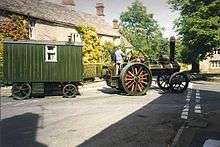Living van

A living van is a portable caravan, used by the itinerant crew of a traction engine.[1]
Living vans developed from the earlier shepherd's wagons, used to provide portable accommodation following a flock as they were moved between pastures.
Traction engines in the Victorian period represented an expensive capital investment in the latest agricultural technology of the period. Many were owned by contractors who would move them from farm to farm for hire, as required.[2] Typical work included threshing around harvest time. A rake of engine, threshing machine, a living van and often a water cart[lower-roman 1] would travel from farm to farm as needed, stopping at each for a few days. The first engines, from around 1840, were portable engines: movable steam engines that were horse-drawn to move them, unlit, between farms.[3] From the 1860s the locomotive traction engine appeared, now capable of moving under its own power.[4] The engine's crew would include a driver, a steersman, and usually a boy. The agricultural labourers carrying out the threshing work would already be resident on the farm.
Larger engines, working in pairs, were also used as ploughing engines. These too were itinerant and would pull a living van and the balance plough behind them.
In his last TV series, Fred Dibnah's Made in Britain, Fred Dibnah travelled around industrial Britain with his traction engine drawing its living van — although, owing to his advanced illness, he was no longer able to live in it.
Construction
The vans were constructed of wood, usually vertically matchboard panelled, on a wooden chassis. Traditionally they were painted dark green. The roof was curved, of canvas over a wooden frame. This would be tarred or treated as oilcloth for weatherproofing. Shepherd's wagons were often of corrugated iron, although this does not seem to have been used for wagons that were regularly towed on roads. Some small windows were provided, for light and ventilation and often too high for a view out. They had a four wheel chassis, the front axle having simple single-pivot platform steering. Steering followed the drawbar from the engine, rather than being steered. Distinctively from earlier horse-drawn wagons, no driver's position was needed at their front. There were no brakes fitted, although wheel chocks were always carried.
Wheels were of cast iron, sometimes wooden artillery or cart wheels for early examples. Fowler, builders of ploughing engines, built riveted steel-spoked wheels, as for the engines themselves.[5] Their large vans differed distinctively from other makers in numerous details: side doors rather than rear, horizontal panelling and also common use of a clerestory window above. Later vans, from around 1900, carried solid rubber tyres. Modern examples have sometimes been refitted with pneumatic tyres. Living vans for steam roller gangs on road construction began using pneumatic tyres in the 1930s, to avoid damage to newly-laid asphalt.
As much of the agricultural work was seasonal, living vans often did not require or include a stove for heating and cooking. The engine's own firebox would be used instead.
Showman's wagons

Agricultural living vans were plain, even when occupied by owner drivers. In contrast, showmen became known for their opulent and beautifully decorated wagons. These were distinguished by cut glass windows, lace curtains and even more engraved glass inside fronting display cabinets for china, ideally Royal Crown Derby.[6]
Showman's wagons are sought after today and are still used by new circus families.[7][8]
References
| Wikimedia Commons has media related to Living vans. |
- ↑ The main arable areas in the UK for cereal crops are in East Anglia and are also relatively arid.
- ↑ Nick Holt (September 24, 2014). "More heavy horse and living van…".
- ↑ Johnson, Brian (1971). Steam Traction Engines, Wagons and Rollers. Blandford Press. p. 42. ISBN 07137-0547-7.
- ↑ Johnson (1971), pp. 16–17.
- ↑ Johnson (1971), pp. 18–19.
- ↑ "Fowler Ploughing Van". Preston Steam Services. Retrieved 2015-06-21.
- ↑ "Living Vans". Carter's Steam Fair.
- ↑ "The Bullzini Family".
- ↑ "Bullzini Family Living Van At Glastonbury 2014". Traveller Homes. June 2014.